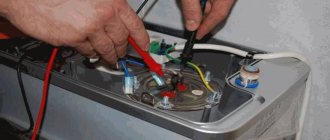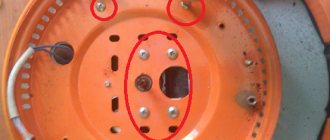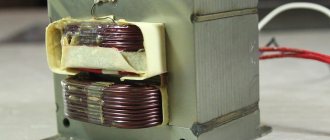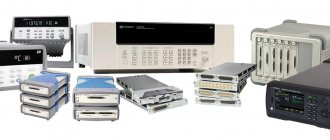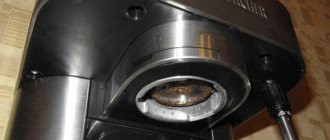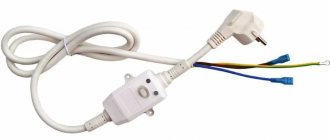Do-it-yourself microwave repair
Repairing a microwave oven requires special professional knowledge and skills. But with a little knowledge of the basics of electrical and radio engineering, and knowing how to use electrical tools, you can try to cope with this problem, even if you are a builder, musician or doctor. To make repairs yourself, just remember what you were taught at school during labor lessons. In this case, you must follow electrical safety rules: do not make short circuits when connecting wires, and do not stick your fingers into the socket. If you are not confident in yourself, then it is better to contact a specialist service center.
Design
To repair Panasonic microwaves at home with your own hands, you need to know the basic elements that ensure its operation. Microwave, be it Mystery 2018g; or any other, consists of the following functional blocks:
- magnetron connected to the chamber by a waveguide;
- transformer;
- high voltage fuse;
- high voltage diode;
- capacitor;
- control unit.
Microwave design.
The magnetron is located in the center of the compartment. The transformer, consisting of a stacked metal core with a coil, is placed below. On the right side of it there is a board with a capacitor, diode and fuse. The control unit is usually located next to the operating mode setting panel.
When the stove is turned on, 2 voltages appear on the secondary windings of the transformer - 6.3 V and 2 kV.
Low is fed to the magnetron filament, and high is fed to a voltage doubler, consisting of a diode and capacitor, and then to the anode. The result is microwave radiation, which is used by ovens to heat and cook food. The microwave power is adjusted using the microwave control unit.
Principle of operation
After connecting the microwave to the network, a voltage of 220V is supplied to the first winding of the transformer. Automatically the voltage is transferred to the secondary winding. The chamber heating system starts. Due to the fact that these two windings are isolated from each other, safe operation of the microwave oven is ensured. A microwave oven allows you to heat food at high speeds by using double the voltage. In this circuit, the main role is played by a capacitor, to which a diode is connected in parallel. The duration and magnitude of the temperature regime helps to control the temperature sensor and a regular timer. For safe use, the oven has a built-in power protection relay, the function of which is to stop the operation of the microwave in the event of high voltage drops in the network or when the door is open. If all this description seems complicated to you, then don’t worry: we’ll figure it out now.
Checking the locking system
Regardless of the microwave oven model, there is a magnetron inside, which is a radio-emitting device. If precautions are not taken, radiation can cause enormous harm to human health. The door with transparent glass and metal mesh prevents radiation from penetrating outside. It is tightly connected to the body; it is in this place that the electromagnetic wave has zero value.
It is very important to regularly diagnose the locking system:
- First, inspect the door to determine the tightness of the seal and the security of the lock. You can use a sheet of paper for this.
- Place it between the doors and the body, press it, and try to remove it from the chamber.
- If effort is made to remove the paper, then everything is in order. If the sheet comes out freely, it indicates that the door needs to be adjusted.
- Settings are made in two places: the hinge area and the lock area. The main goal is to tightly fit the door to the base so that the radiation does not spread beyond the boundaries of the household appliance.
- Particular attention should be paid to the microswitch, both in the open and closed states. Test them using a tester and if problems are found, replace both, since they have the same service life.
To reduce the gap you need to:
- loosen the screws securing the door hinges;
- press the upper part of the sash so that the seal fits tightly to the oven chamber;
- tighten the door hinge screws.
Attention! The microwave will not turn on unless a signal is sent to the electronic control module that the door is closed. In this case, the contacts are open, which means the limit switch is broken. It should be replaced.
Signs of a microwave oven breakdown
Most often, external signs of a microwave oven malfunctioning are the appearance of sparks, puffs of smoke, the plate stopping from rotating, and the lack of heating of food placed in the oven. Or the microwave simply won’t turn on. In this case, it is dangerous to plug it into the network! There are three main reasons for electrical appliance failure:
- Fuses blown;
- Magnetron malfunction;
- Burnout of the mica plate.
In case of this type of breakdown, you can repair the stove if you follow the instructions strictly. First, consider the functional diagram of a microwave oven. We take the functional diagram because It makes it easier to understand the operating principle of a microwave oven, it is universal, regardless of the brand of the oven, it is simpler compared to the circuit diagram of a microwave oven.
And the location of the microwave elements can be seen in this figure:
The stove doesn't heat
In the microwave, the backlight works, the plate rotates, the grill also works, but the food in the device does not warm up. The reason is the failure of a high-voltage capacitor or magnetron.
In rare cases, this may be a malfunction of the high-voltage transformer. In this case, repairing it yourself will be difficult; it is better to contact microwave oven repair professionals.
To identify the cause, a diagnosis should be made:
- when starting the furnace, check the presence of voltage on the primary winding (observe safety precautions);
- if there is voltage, make sure that the contacts on the high-voltage transformer, high-voltage diode and magnetron are reliable;
- if all contacts are normal, it is necessary to replace the magnetron or high-voltage diode.
Fuse blown
This is the most common cause of failure. There are two fuses in the microwave. The first F1, the so-called mains fuse, is located at the input of the 220 volt mains voltage into the microwave oven. So he can burn out. In this case, the oven stops turning on and does not react in any way when you press any buttons. First, you need to diagnose the microwave oven: remove the mounting screws from the back side and open the protective panel. Do not forget to unplug the plug from the socket before starting repair work. Then you need to forcefully discharge the filter capacitor. To do this, its terminals are closed (i.e., connected to each other) using an insulated wire. Be sure to hold the wire strictly by its insulation. After this, check for voltage on the surge protector board and check the condition of the microwave power wires. If there are no faults in this part, you should inspect the diode in the rectifier circuit of the power supply. Most often, it is this that causes the fuse to blow in this type of breakdown. The fuse in the microwave should be checked for openness visually or using an ohmmeter, if necessary, replace it with a serviceable one and analyze the causes of the blown, in order to avoid a repetition of a similar situation, paying attention to various darkening of the radio elements, which indicate a malfunction in the microwave units. The second fuse F2 is located after the high-voltage transformer in the magnetron circuit and is called high-voltage. It is “hidden” in a plastic tube-shaped case and located next to the transformer. This fuse fails due to the failure of a high-voltage diode or capacitor. It is better to replace the fuse with a new factory-made one. it is calibrated for the desired operating current. Well, it is imperative to replace the part that led to the fuse burning. Below, watch a video about how, as a last resort, you can repair a high-voltage microwave oven fuse yourself:
When to ring a transformer
The transformer converts the network voltage that is necessary for the magnetron to operate. It needs to be given enough attention, as it often causes the microwave to break down.
Transformer failure is one of the most common causes of failure.
The high-voltage transformer is ringed, provided that the load is turned off, as well as the primary winding. The procedure should be carried out this way:
- Using pliers, remove the terminals.
- Check the resistance of the primary winding, the standard value of which is 1.5 Ohms. The indicator of the secondary filament winding and high-voltage winding are the corresponding values - 0.1 Ohm and 110 - 120 Ohm.
- If during the test it was not possible to ring at least one winding, this is a sign of failure of the transformer. Replacement is required; there is a special connector in the magnetron design to connect it.
You can find out the resistance value between the case and the terminals if you disconnect the terminals. If the process is successful, you need to look for damage in the filter at the feed-through capacitors. To fix the problem you should:
- install a new capacitor or buy an assembled filter of a suitable rating,
- remove the magnetron to make sure the condition of the antenna cap,
- Having detected signs of combustion, damage to the housing, and also having determined the life of the magnetron insulator, replace the necessary elements, the main thing is that the parts match the size.
Magnetron malfunction
If the backlight works in the oven, the plate rotates, but the microwave does not heat the food, then most likely the cause of the malfunction is a malfunction of the magnetron. In the above diagram, the magnetron is designated as “magnetron”. A magnetron is a device that generates microwave radiation. That is why if this part fails, the oven does not heat.
The magnetron is housed in a small rectangular metal housing. First you need to clean it and then carry out a visual inspection. Next, inspect the magnetron unit itself. Namely, the integrity of the wires connecting the terminals and the housing. Often the reason the magnetron does not work is the failure of the feed-through capacitor. Below watch the video on how to repair a microwave oven magnetron with your own hands:
After this, be sure to check the microwave control unit. Again, pay attention to burnt, sooty and dirty areas. It is these parts that will need to be replaced for the microwave to continue operating.
How does a microwave oven work?
Before you decide to repair the stove yourself, you should understand the design and structure of the device. A conventional microwave oven consists of a magnetron, capacitor, transformer, diode and fan. Modern models can have auxiliary elements, such as a grill.
Magnetron
The heart of a microwave oven is called a magnetron, the energy of which is converted into heat. This operating principle is available due to the anode-filament stabilizer (transformer). The housing of the electronic device is placed in a special plate radiator, which is constantly blown by a fan. To prevent the part from overheating, it is equipped with a special thermal fuse. In the first microwaves, it was the magnetron that took the lion's share of the cost. However, over time, the price became affordable, after which mass production was launched.
Fan
Another important element in the design of the device is a fan, thanks to which the chamber, magnetron and grill are blown. The fan allows accumulated air and water vapor to escape. Air circulation in the chamber is available through air ducts located inside the microwave.
Shielded chamber
Regardless of the cost and model, any stove has a shielded chamber. The metal-protected chamber prevents microwave rays from escaping. There is a special mesh on the glass, which is designed to hold the rays inside the microwave. It is also necessary to ensure that the door always fits tightly to the body. Do not use the device if the door does not close.
Control block
The control panel is designed to control and support the installed power of the device. These functions can be called basic. More advanced models have expanded functionality, which includes: timer, time and power indicators, auto menu programs, sound alarm and others.
Important! Never turn on the microwave without power. One of the consequences of neglecting this rule is the failure of the magnetron, which costs as much as half a microwave oven.
Common microwave oven failures and how to detect them
If your microwave oven does not work well or does not turn on at all, you can repair it yourself by finding the cause of the malfunction. Basically, all models of microwave ovens have the same device, and therefore they break down in almost the same way.
The microwave does not heat and there is a smell of burnt insulation.
- Short circuit between the turns of the transformer. The resistance of the primary winding of a working transformer is in the range of 2.3 - 3 Ohms. If the resistance measured with a multimeter is less than 2 ohms, this means that an interturn short circuit has occurred in the winding. The resistance of the secondary high-voltage winding should be about 150 Ohms. If, after taking measurements between the device body and the high-voltage terminal, you find a significant resistance deviation or a winding break, it means the transformer is damaged.
- Breakdown of a high-voltage capacitor. The resistance of a working capacitor should not be less than 10 MOhm, and also not equal to infinity, because this indicates an open circuit.
- Failure of the high voltage diode. Everything is simple here, if during measurement the diode shows a resistance close to zero, it means it is broken.
- The magnetron burned out. A voltage of 4 kV is supplied from the high-voltage, filament winding of the transformer to the magnetron, therefore, if the insulation is broken, breakdown easily occurs from the wave emitter to the housing. In this case, the magnetron cap often melts.
The microwave oven does not turn on and the program cannot be set.
- The power socket is faulty. First, make sure there is voltage at the outlet. Connect the appliance to a different outlet.
- The fuse has blown. If the mains voltage is connected, but the stove does not turn on, most likely one of the two fuses has blown. The first fuse is a fuse and is installed in the power supply circuit from the mains voltage. The second fuse is a temperature sensor, which is located on the surface of the heating chamber.
- The micro switch is broken. When the small limit switch is broken, then its open contacts do not signal the electronic control module to close the door, and the oven does not turn on.
- The control module or board is faulty. A conclusion about the failure of the control module can be made only after the following have been checked: fuses, micro-switch, furnace transformer. But if individual buttons on the control module did not work before, then it is probably broken.
The microwave oven sparks inside.
- The magnetron cover is burnt out. The mica plate located inside the heating chamber on the right side is often carburized. This occurs when the surface of the emitter cover, contaminated with splashes of grease, begins to burn during operation of the oven.
- Damage to enamel. Do not try to restore the insulating coating inside the heating chamber with ordinary paints or putties, as the fumes from these non-specialized products will poison the food.
- Broken door latch. Replace the broken latch as quickly as possible, because when the door is not tightly closed, microwaves come out of the inner chamber and irradiate everyone who is near the microwave oven.
The microwave oven does not stop after the timer ends.
- Relay is faulty. This intermediate relay connects voltage to the primary winding of the transformer. The cause of the relay malfunction may be its mechanical failure, or burnt contacts.
- The control module or board is faulty. You need to check the control module with keys, and it is better to replace it.
The tray does not rotate in the microwave oven.
- Malfunction of the plate rotation drive. If one tooth breaks off on a plastic gear, you can replace it with a metal insert. But if the gear is worn evenly, it will have to be replaced.
- The drive motor has failed. A restored broken engine will still not work for long after repair, so it is better to buy a new one.
The microwave oven is overheating.
- Wrong choice of location for installing the stove. Do not install the microwave oven close to other heating devices or in direct sunlight, otherwise it will quickly overheat during operation.
- Fan failure. This device can break down both mechanically and electrically. In any case, you will have to disassemble the fan, and if necessary, replace its blades, motor bearings, or the entire electric motor.
The grill does not work in the microwave oven.
- The heating element has burned out. It is very easy to check a tubular electric heater: if, when measured with a multimeter, the resistance at the contacts is equal to infinity, then the heating element is unusable.
The lighting lamp does not light.
- The lamp has burned out. If the backlight does not work, check the incandescent lamp first.
- The backlight switching circuit is broken. After replacing the lamp, the backlight still does not work - this means there is no contact with the power circuit of the lighting lamp.
Diagnosis and Troubleshooting
High voltage fuse blown
Among the common breakdowns is a malfunction of the high voltage fuse. In the event of a breakdown, the microwave stops turning on and no longer responds to button presses. Before carrying out diagnostics, it is necessary to discharge the high-voltage capacitor, and then remove the protective casing by unscrewing the fastening screws. Next, using an ampere-voltmeter, you should check the voltage in the surge protector.
Most often, the diode is located on the power filter board. If a part burns out, it should be replaced immediately. After the repair, it is necessary to find out the cause of the overload, which is why the fuse failed.
If swelling or darkening is found on the parts of the device, it is necessary to check the control unit. If after replacing the fuse there is no change in the operation of the device, the problem may lie in the transformer board.
Magnetron malfunction
This is the most common malfunction that awaits microwave oven owners. If the stove does not heat up, you need to understand the operation of the magnetron. To detect damage, inspect the internal walls of the device. If there is no mechanical damage, remove the plate from the left side of the compartment and clean it with a weak alcohol solution. After cleaning, you can begin checking the functionality of the element. If darkening or burnt holes are detected, replace the faulty mechanism.
After cleaning the surfaces, you can begin diagnosing the unit. To detect a breakdown, visually inspect the condition of the insulation between the device body and the terminals. Resistance in the area being diagnosed indicates a malfunction of the capacitors in the filter. In this case, repairs may be limited to replacing the filter and capacitor unit. Next, you should inspect the metal cap and, if damaged, replace it with a new one.
Burnt mica plate
Another common cause of microwave problems is a burnt mica plate. However, this malfunction can be repaired with your own hands. One of the symptoms of a breakdown is sparks in the wave channel area. Why did this happen and how to fix it?
During the cooking process, some products may splatter, resulting in the mica becoming soggy. To avoid future damage, cook and reheat food only in sealed containers. So, what to do if you couldn’t prevent burnout:
- Stock up on working tools: scissors, sandpaper, an awl and a file.
- Unscrew the top cover and door of the device.
- Take out the old plate and magnetron.
- Use a file to file the waveguide slot.
- Get rid of sharp metal edges caused by mica burning.
- Clean the wave channel with sandpaper.
- Treat burnt equipment parts.
- Remove dirt from the inner chamber and wave channel.
- Inspect the magnetron unit.
- Replace the metal cap if necessary.
- Using the instructions, install the magnetron.
- Screw the door leaves.
- Start the stove by placing a bowl of water inside.
- Apply a new layer of mica to the burnt plate.
- Trace the outline of the plate using an awl.
- Install the mica plate.
Common microwave oven malfunctions and their causes
We have long been accustomed to heating and defrosting food in the microwave. The microwave oven has long and firmly entered our everyday life and won its place there. And when suddenly this useful device fails, it greatly upsets us. If you have some knowledge in the field of electromechanics and radio engineering, then in the event of a minor breakdown, you can try to repair the microwave oven yourself. But if a significant malfunction occurs or your knowledge is insufficient, it is better to use the services of a professional technician.
Burnout of protective mica
The most common malfunction is the failure of the waveguide cover in the microwave oven chamber. This is caused by splashes from cooking. This starts sparking between the magnetron antenna and the protective cover. Untimely removal of burnt food leads to local burnout of the lid and complete destruction.
Local burnout of the mica plate of the lid can be removed using alcohol or solvent 646. It is enough to carefully wipe the burnt area.
Burnout of mica
If the mica plate of the lid is in clearly poor condition, is greased or has become discolored, it should be replaced. Removing the diffuser plate is not difficult at all. This can be done using a regular sharpened knife. Usually the mica plate is attached with a self-tapping screw or rivets. Carefully place the old plate on the new template and cut out a new one. It is best to do this with a knife - scissors can break the mica. We make holes in the new plate with a sharp screwdriver and sand the edges of the plate fields with sandpaper. We install the new plate in place of the old one.
The question often arises: what to replace mica for microwaves with? Any dielectric with a similar dielectric constant characteristic is suitable for these purposes. For example, fluoroplastic or Teflon.
Why do microwave ovens break down?
It is believed that a microwave oven is a fairly reliable unit that rarely fails. And most often, the reasons for its breakdown are improper operation and wear of parts during long-term use of the device. So why might a microwave break?
- When heating, utensils that are not suitable for microwave use are used. Only glass or plastic containers can be used in the SChV. The container lid must be open. When heating with a tightly closed lid, the cookware may explode, which will damage the inner chamber and parts of the stove.
- There is a metal object in the microwave while it is running. Often, users leave cutlery in dishes, which can lead to sparking, cracking and puncture on the inner surface of the chamber. The same consequences will result from using metal utensils or utensils with foil patterns applied to them.
- When heating food, a special plastic cap is not used. It protects the chamber walls and internal elements from contamination by drops of liquid and fat that evaporate from the surface of the dish when heated.
Main causes of breakdowns
Do not forget that natural wear and tear is quite normal, and if the equipment is more than 10-15 years old, breakdowns are quite expected. Also, users themselves are often to blame for failures because they do not follow the rules of use, although there is nothing complicated about them:
- Avoid using metal utensils or gold-plated plates.
- Do not start the stove with an empty chamber.
- Heat only approved products. For example, it is not recommended to load eggs and peeled fruits or vegetables into the chamber - this can lead to the product exploding.
So, we found out why the microwave may not turn on or, on the contrary, may work continuously. When performing manipulations on your own, follow safety precautions, or better yet, contact a specialist. If you learn something new from the operating rules, be sure to take note. Happy using!
Source: 270076.ru
Diagnosing microwave malfunctions
You can determine whether a microwave oven is truly hollow using the method of elimination. To do this, inspect the unit and check the functioning of the following elements:
- You need to start by checking the integrity of the power cord and outlet. If there is a break in the cord or an overloaded outlet, the microwave will not work. Here you should pay attention that the microwave oven is sensitive to the mains voltage. If the voltage is lower than 220 volts, the device does not work.
- The next step is to check the tightness of the door closure. Microwaves are dangerous to human health. And therefore the oven is designed in such a way that it can operate with the door tightly closed. If the lock on the door, the locking system or the closing element is broken, the microwave will not turn on.
- The last step is to check the fuse and thermal relay. The mains fuse may blow due to a sudden voltage drop in the network or a short circuit. If you replace the fuse, the device will work properly. The thermal relay turns off the operation of the device when the door is open. If the thermostat is not working properly, it needs to be replaced.
The microwave does not start: the main reasons
If the MVP stops turning on, the first thing the user should check is whether the equipment is securely connected to the outlet. A faulty socket may be the “nail in the wheel” that causes the microwave to turn off and no longer turn on. The easiest way to check serviceability is to include another working device in it. Does not work? Now find a working outlet and plug the MVP into it. Works? This means the socket is 100% at fault.
Circuit breakers
If the problem is ruled out, it is worth checking the power cord and fuses - there are two of them in the microwave: high-voltage and temperature sensors.
A burnt-out element needs urgent replacement, but it’s worth considering that since the microwave broke down due to a blown fuse, it’s not just that – there’s a problem that caused the overload. Your task is to visually inspect the internal parts of the stove for dark spots, burnt areas, drips, swelling, burning smell, etc. Repairs (with your own hands or with the help of a specialist) are carried out depending on the type of problem detected.
Transformer
The most vulnerable parts of the transformer are the winding and the temperature fuse. Finding a breakdown boils down to disassembling the stove, so it’s not worth repairing it yourself - it’s better to contact a service center and not break the seal, so as not to lose the current warranty (if it has not yet expired).
Control block
Did the check show that all of the listed elements are in working order? It is possible that the problem is caused by a failure of the control board. What to do? First of all, you need to remove the board and inspect it visually. There is a fuse on the board that often blows. Also inspect the traces - if you find swollen capacitors, damaged diodes and zener diodes, look for the problem.
Not good with electronics? Entrust the work to a specialist. Moreover, it is difficult for us to give you further instructions for action, due to the huge variety of profit center schemes - each brand and even model range has its own schemes.
Basic malfunctions of microwave ovens
Microwave won't turn on
There may be several reasons why the microwave oven does not turn on:
- The power cord is faulty. It may be broken or the wire contacts have come loose from the control board. The malfunction can be eliminated by soldering the contacts, and if the problem is in the cord, by replacing it.
- The high voltage fuse has blown. It needs to be replaced.
- The door lock microswitch is broken. It needs to be replaced or the contacts restored.
- The thermostat is not working. Here you need to figure out whether the thermostat has burned out and needs to be replaced, or there is a malfunction in the cooling system of the furnace chamber. A competent technician will be able to figure out the problem.
- The control board has failed. Frequent causes of this malfunction are voltage surges. The step-down transformer on the board most often fails, and various radio elements of the supply circuit break less often.
The plate doesn't spin
The plate rotates poorly or does not rotate at all due to a malfunction of the motor that rotates the tray. Most often, the engine breaks down due to drops of water, grease and food particles adhering to the shaft. This leads to difficulty in rotating the shaft, increasing the load on the coil and causing it to burn out. If rotation difficulties arise, the shaft can be carefully cleaned of dirt. If the coil burns out, it needs to be replaced.
Another reason may be a violation of the integrity of the electrical circuit.
Microwave doesn't heat
- The fuse has blown. It needs to be replaced.
- Magnetron failure. The causes of such breakdowns can be voltage surges in the network, short circuit, capacitor malfunction, as well as element wear. A qualified technician can deal with the causes of magnetron malfunction.
- The network voltage is below 220V.
Sparking and crackling in the microwave chamber
Such signs indicate that the mica platinum has burned out. The reason for this is heating food in an open container. This causes liquid and fat to evaporate from the surface of the dish and settle on the plate. Also, mica can burn out if there is any metal object, even a small one, in the chamber. Or excessive wetting of the plate during cleaning.
The microwave oven makes a loud noise
If operated for a long time at maximum mode, the magnetron may fail. A short circuit may also occur in one of the windings of the high-voltage transformer, which also leads to increased sound. Fan malfunction also results in increased sound and noise.
Touchpad buttons don't work
During operation, the contacts on the buttons are broken. They require restoration, or a complete replacement of the button or touch panel. Also, the lack of response to pressing a button may indicate a malfunction of the control unit.
The light in the oven chamber does not light up
The chamber light turns on when the door is opened and while the microwave is operating. The absence of backlight indicates that the light bulb has exhausted its life and has burned out. It needs to be replaced. Less often, the light bulb does not light up due to wiring faults.
These and many other microwave malfunctions can be easily fixed by a technician from. We have been working with all brands of microwave ovens for more than 15 years and will be happy to come to your aid in any situation. You can call a specialist today by phone or using a special form on the website.
Electrical circuit, structure and principle of operation of a microwave oven
From a household electrical outlet, the supply voltage is supplied directly to the filter board through a plug and cord. There is no traditional switch in a microwave oven.
The filter is used to suppress high-frequency radio interference emitted by the stove circuit, and a tubular fuse F1 is installed in the block for a current of 8 to 12 A. The fuse blows if a short circuit occurs in the circuit.
Next, the supply voltage is supplied to two limit switches SWA and SWB, which block the supply of voltage to the magnetron and other circuit elements to prevent the stove from being turned on when the door is open. This safety measure was taken to prevent human exposure to microwave waves.
The SWC limit switch is designed to short-circuit the supply wires in case the contacts of the SWA and SWB switches are closed when the door is open. In this case, fuse F1 will blow, and the stove circuit will be de-energized. I think that this measure is unnecessary, since such a case is incredible in practice and only reduces the reliability of the stove.
The FU thermal fuse trips when the magnetron heats up to a temperature above the permissible temperature, usually 80°C. The operating temperature of the thermal fuse is always indicated on its body. In the normal state, the resistance between its terminals should be zero, and when triggered, it should be infinity.
If the limit switches are closed, then the supply voltage is supplied to the control circuit, which, when the food heating mode is turned on, supplies voltage to the magnetron cooling fan, the plate rotation motor, the stove chamber lighting lamp and the magnetron power supply transformer.
The transformer has two secondary windings. One is for heating the magnetron filament with a voltage of 3.15 V with a load current of up to 10 A. The second winding is high-voltage, producing a voltage of about 2000 V. Using a high-voltage capacitor C and diode D, the voltage is rectified and multiplied to 4000 V, which is necessary for the operation of the magnetron. Fuse F2 serves to protect the transformer in the event of a breakdown of the diode, capacitor or magnetron.
Recently, microwave ovens have appeared in which, instead of a power transformer, diode and capacitor, an electronic inverter is installed, which allows smooth control of the magnetron power, which reduces the weight of the oven, the uniformity of heating of products, but is more expensive.
As you can see, the electrical circuit of a microwave oven is not at all complicated and, by understanding the principle of its operation, you can independently find and fix the fault at home, having only a multimeter at hand.
If you remove the cover of the microwave oven, the picture shown in the photograph will open. All stove models are designed the same, and the blocks are placed in the same places on the body. Older stove models differ only in the control unit. In modern microwave ovens, the electromechanical timer is replaced by a microprocessor electronic unit, and the power transformer is replaced by an electronic one (inverter).
Common microwave oven malfunctions and their causes
We have long been accustomed to heating and defrosting food in the microwave. The microwave oven has long and firmly entered our everyday life and won its place there. And when suddenly this useful device fails, it greatly upsets us. If you have some knowledge in the field of electromechanics and radio engineering, then in the event of a minor breakdown, you can try to repair the microwave oven yourself. But if a significant malfunction occurs or your knowledge is insufficient, it is better to use the services of a professional technician.
Why do microwave ovens break down?
It is believed that a microwave oven is a fairly reliable unit that rarely fails. And most often, the reasons for its breakdown are improper operation and wear of parts during long-term use of the device. So why might a microwave break?
- When heating, utensils that are not suitable for microwave use are used. Only glass or plastic containers can be used in the SChV. The container lid must be open. When heating with a tightly closed lid, the cookware may explode, which will damage the inner chamber and parts of the stove.
- There is a metal object in the microwave while it is running. Often, users leave cutlery in dishes, which can lead to sparking, cracking and puncture on the inner surface of the chamber. The same consequences will result from using metal utensils or utensils with foil patterns applied to them.
- When heating food, a special plastic cap is not used. It protects the chamber walls and internal elements from contamination by drops of liquid and fat that evaporate from the surface of the dish when heated.
The furnace sparks
This cause occurs in microwave ovens that have a mica plate covering the magnetron. Why does a microwave oven spark and crackle? Before you carry out repairs yourself, you need to know the reasons:
- Overheating of the mica plate, which is caused by drops of fat falling on it. We should not turn a blind eye to this problem. It can lead to burnout of an expensive magnetron.
- Damage to the enamel in the chamber. Occurs due to irregular cleaning of the walls, fat or food particles accumulate. These contaminants cause sparks to occur.
- Check if there are any metal products inside the stove. A coated plate or spoon and fork may cause sparks.
To eliminate the first malfunction, you need to replace the old plate with a new one. You can order the necessary material in the online store, on one of the sites you trust. The dimensions of the mica will not coincide with the inside of the microwave oven, they will be slightly larger.
- remove the failed plate using a tool, as it is secured with plastic latches or self-tapping screws;
- place an old piece of mica on the purchased material, cut the part strictly to size;
- install a new plate;
- Check the oven for functionality by placing a glass of water in it.
Microwaves, not encountering any obstacles in their path, move on, being reflected on the walls of the chamber. The device will not turn off until the timer goes off, and the concentrated energy will negatively affect the microwave parts.
To cut the plate correctly you need to:
- Use a sharp knife and a metal ruler.
- Make holes for fasteners using a drill or a special punch.
- Sand the sharp ends of the plate with sandpaper (fine-grained).
- Eliminate all contaminated areas that were discovered when removing the old mica plate.
- Install the new part into place.
To eliminate the second problem - damage to the enamel, you should purchase a special product and apply it to the internal walls of the microwave oven (organosilicon paint). It will not release harmful substances into food and is resistant to temperature changes. It is prohibited to use non-specialized substances that not only lead to damage to the device itself, but also harm human health.
If the sparks were caused by the presence of metal products inside the stove, then they simply need to be removed to eliminate the problem.
Diagnosing microwave malfunctions
You can determine whether a microwave oven is truly hollow using the method of elimination. To do this, inspect the unit and check the functioning of the following elements:
- You need to start by checking the integrity of the power cord and outlet. If there is a break in the cord or an overloaded outlet, the microwave will not work. Here you should pay attention that the microwave oven is sensitive to the mains voltage. If the voltage is lower than 220 volts, the device does not work.
- The next step is to check the tightness of the door closure. Microwaves are dangerous to human health. And therefore the oven is designed in such a way that it can operate with the door tightly closed. If the lock on the door, the locking system or the closing element is broken, the microwave will not turn on.
- The last step is to check the fuse and thermal relay. The mains fuse may blow due to a sudden voltage drop in the network or a short circuit. If you replace the fuse, the device will work properly. The thermal relay turns off the operation of the device when the door is open. If the thermostat is not working properly, it needs to be replaced.
Troubleshooting Methods
Let's look at ways to solve the most common microwave oven breakdowns.
The device does not turn on
First of all, check the cord and the fit of the socket, then check the serviceability of the fuses. Fuses burn out when there is a short circuit or sudden voltage drop. If replacing the fuse did not yield anything, then most likely the reason lies in the short circuit of the transformer or diode (for more details, see the article on what to do if the microwave does not turn on).
You can change the microwave fuses yourself; it is advisable to coordinate the elimination of other faults with specialists.
Periodic switching on/off of the oven
Most likely, the problem is in the fan - either the relay is broken, or the ventilation holes are inaccessible. The fan needs to be replaced.
Stop lighting
The microwave backlight, located inside, turns on when the door of the device is opened and during operation. The standard reason this doesn't happen is because the light bulb needs to be replaced. Less often, the reason lies in backlight malfunctions. It is quite possible to replace the light bulb inside the microwave yourself; in other cases, it is better to contact a specialist.
Sparks and burning smell
The problem is a mica plate that has been burnt by dirt or improper use. The plate is pierced due to strong fatty deposits, as well as when the oven chamber is washed abundantly with water. Using utensils with a metallic “shiny” coating will also almost certainly damage the microwave. If you do not replace the plate on time and continue to use the stove, you can “wait” for more serious breakdowns, which will be difficult and expensive to fix. More detailed information is presented in the article why a microwave oven sparks inside).
Enamel defects
They can appear both in the chamber itself and on the microwave door. Associated either with a manufacturing defect or with careless use of the device. Without eliminating such defects, you cannot continue to use the oven.
No heating
Maybe it’s a fuse that burned out as a result of a shorted magnetron or transformer, or a broken capacitor (for all the reasons, see the article on why the microwave doesn’t heat). The magnetron has its own useful service life, which is determined by the gradually decreasing emission capacity of the cathode; this period is also reduced by unstable voltage. All manipulations with the magnetron are recommended to be carried out in a specialized service center.
Display does not work
The symbols on the microwave display appear jagged. Typically this means the processor is damaged. It is possible that the loop contacts have become dirty, or the loop itself has come loose. If the board is damaged, similar symptoms are also possible. It is recommended to contact the service.
The tray rotates jerkily or does not rotate at all
During normal operation, the tray in the microwave chamber should rotate very smoothly; if this does not happen, it means that the grooves are dirty. You can easily deal with this breakdown yourself by cleaning them, and at the same time cleaning the roller itself. If you ignore this problem, then over time the motor coil will fail, since when the shaft rotates with difficulty, the load on the coil increases significantly.
Microwave buttons don't work
In this case, you need to check the entire circuit with a tester, replace the failed buttons and solder the contacts in the right places. Most often, the entire touch panel/control panel needs to be replaced; sometimes a cable comes off the board (for more details, see the article on what to do if the buttons on the microwave do not work).
Basic malfunctions of microwave ovens
Microwave won't turn on
There may be several reasons why the microwave oven does not turn on:
- The power cord is faulty. It may be broken or the wire contacts have come loose from the control board. The malfunction can be eliminated by soldering the contacts, and if the problem is in the cord, by replacing it.
- The high voltage fuse has blown. It needs to be replaced.
- The door lock microswitch is broken. It needs to be replaced or the contacts restored.
- The thermostat is not working. Here you need to figure out whether the thermostat has burned out and needs to be replaced, or there is a malfunction in the cooling system of the furnace chamber. A competent technician will be able to figure out the problem.
- The control board has failed. Frequent causes of this malfunction are voltage surges. The step-down transformer on the board most often fails, and various radio elements of the supply circuit break less often.
The plate doesn't spin
The plate rotates poorly or does not rotate at all due to a malfunction of the motor that rotates the tray. Most often, the engine breaks down due to drops of water, grease and food particles adhering to the shaft. This leads to difficulty in rotating the shaft, increasing the load on the coil and causing it to burn out. If rotation difficulties arise, the shaft can be carefully cleaned of dirt. If the coil burns out, it needs to be replaced.
Another reason may be a violation of the integrity of the electrical circuit.
Microwave doesn't heat
- The fuse has blown. It needs to be replaced.
- Magnetron failure. The causes of such breakdowns can be voltage surges in the network, short circuit, capacitor malfunction, as well as element wear. A qualified technician can deal with the causes of magnetron malfunction.
- The network voltage is below 220V.
Sparking and crackling in the microwave chamber
Such signs indicate that the mica platinum has burned out. The reason for this is heating food in an open container. This causes liquid and fat to evaporate from the surface of the dish and settle on the plate. Also, mica can burn out if there is any metal object, even a small one, in the chamber. Or excessive wetting of the plate during cleaning.
The microwave oven makes a loud noise
If operated for a long time at maximum mode, the magnetron may fail. A short circuit may also occur in one of the windings of the high-voltage transformer, which also leads to increased sound. Fan malfunction also results in increased sound and noise.
Touchpad buttons don't work
During operation, the contacts on the buttons are broken. They require restoration, or a complete replacement of the button or touch panel. Also, the lack of response to pressing a button may indicate a malfunction of the control unit.
The light in the oven chamber does not light up
The chamber light turns on when the door is opened and while the microwave is operating. The absence of backlight indicates that the light bulb has exhausted its life and has burned out. It needs to be replaced. Less often, the light bulb does not light up due to wiring faults.
These and many other microwave malfunctions can be easily fixed by a technician from. We have been working with all brands of microwave ovens for more than 15 years and will be happy to come to your aid in any situation. You can call a specialist today by phone or using a special form on the website.
Troubleshooting
Each breakdown is accompanied by its own symptoms:
- Inside the furnace something sparkles, crackles and shoots. This phenomenon is observed when the mica plate covering the exit of the waveguide into the chamber is destroyed. The same thing happens when the protective cap of the magnetron burns out.
- Food placed in the chamber does not heat up. The tray rotates, the backlight works. The problem occurs due to a blown high-voltage fuse or a breakdown of the capacitor.
- The microwave oven does not heat well. This occurs due to low voltage in the electrical network or loss of emission from the magnetron.
- The oven does not turn on. First, check the integrity of the power cord, fuse and the presence of voltage in the outlet. Then the state of the interlocking microswitches that turn on when the door is closed. If everything is in order, the reason is the oxidation of the contacts of the thermal relay located on the magnetron body.
- The tray does not rotate. The coupling connecting the motor shaft to the sump is cut off or the motor is faulty.
- When operating, the stove, in particular the Mystery mmw, makes a loud humming noise. The transformer or fan is faulty.
- Typed commands are not executed. Perhaps due to the high temperature, the contacts of the control unit were burnt.
- No indication or timer is displayed. The microprocessor is malfunctioning. In this case, repairing the touch control panel should be entrusted to a specialist.

